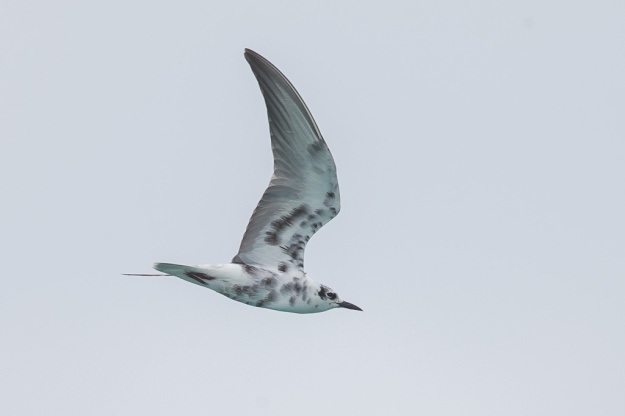
Eastern-crowned Warbler by Joesph Tan Kok Beng.
The excitement on the last day of August went up a notch in September when the migrants were coming in thick and fast. The former Bidadari Cemetery came alive with the return of the big guns. They were lured back to their favourite stomping ground by the appearance of the Flycatchers, Shrikes and Wagtails. The Ferruginous Flycatcher landed on 21st, a new extreme date, followed by the Dark-sided Flycatcher on the 24th and the globally threatened Brown-chested Flycatcher on the 27th. All uncommon species and great ticks for the Big Yearers. Besides these, the photographers had their pick of Asian Paradise Flycatchers (5th), Yellow-rumped Flycatchers (6th), Tiger Shrikes (6th) and Forest Wagtail (13th). The bonuses were a Crow-billed Drongo on the 19th and Siberian Blue Robin on 21st. Both were first winter birds. The Drongo stayed for less than 2 days but the Robin was happy with the handouts and stayed a little longer. Other migrants seen at Bidadari were a flock of 40 Daurian Starlings on the 13th, Asian Brown Flycatchers and the Eastern-crowned Warblers. Other migrant passerines like the Arctic Warbler was recorded at Nee Soon during the FMBC on the 14th, Brown Shrike at Tuas South on the 20th and again the Eastern-crown Warbler at Sungei Buloh on 22th

Great Knots at Seletar Dam by Zacc HD
As for the shorebirds, a total of eight Black-tailed Godwits were counted at Sungei Buloh on the 1st up from the five seen the day before. The star bid of the month were the four rare Great Knots found feeding off the Pang Sua Estuary on the 27th morning (Lau Jiasheng). Two were still there in the evening but gave the chasing Big Yearers the miss by moving over to Seletar Dam the next morning (Zacc HD). They were not seen again. Over at Mandai Mudflats, Rufous-necked Stints, Ruddy Turnstone and a lone Broad-billed Sandpiper were recorded during the Fall Migration Bird Census on 14th. The Ruddy Turnstone also turned up at Seletar Dam on 21st and at Chek Java on the 27th together with the Grey Plovers. The Greater Sand Plover that was feeding at Seletar Dam last month made a one day cameo on the 28th.

Greater Sand Plover at Seletar Dam by Rey Aguila.
The Marsh Terns were returning to the Serangoon Reservoir this month. Both the White-winged and the Whiskered Terns were seen on the 9th while the Swift and Bridled Terns were seen flying off Punggol on the 13th. An unusual large number of Black-naped Terns (100+) were seen off Tanah Merah on the 21st. This could be the largest flock of this resident tern seen near the coast of Singapore.
The first migrant raptor was an Oriental Honey Buzzard seen over Bidadari on the 5th. Four Japanese Sparrowhawks were spotted flying through Tuas South on the 16th, the first for this Autumn. Subsequently the home owner at Blk 20 Dakota Cresent woke up to find a Japanese Sparrowhawk perched on his balcony on the 22nd. Another was reported flying over Japanese Gardens on 30th. This was where a Crested Serpent Eagle was photographed on 21st. There were reports of earlier sightings of this Eagle. Chaiyan later pointed out that this particular eagle was the burmanicus and not the malayensis race. It is larger, more rufous than black. Could most of our previous record of this eagle been this race and not the Malaysian resident?
Interesting reports of our resident species include a hard to find House Swift flying over Seletar Dam (27th) and a feeding Pacific Reef Egret there on the 15th. First record of a pair of Lesser Tree Ducks at the pond at Labrador Park and a tame Java Sparrow feeding with the Mynas at Old Airport Road Hawker Center, a recent release no doubt. Over at the Japanese Gardens, a Cinnamon Bittern was foraging at the lotus pond ( 2nd) and an uncommon non-breeding visiting Malayan Hawk Cuckoo picked out on 24th.
Contributing Observers: Tan Boo Eng, See Toh Yew Wai, Francis Yap, Zacc HD, Lau Jaisheng, Lim Kim Keang, Lim Kim Seng, Rey Aguila, Frankie Lim, Low How Choon, David Li, Lawrence Cher, Toh Yuet Shin, Albert Low, Christina See, Lim Ser Chai, Goh Juan Hui, Geoff Lim and Alan OwYong.































